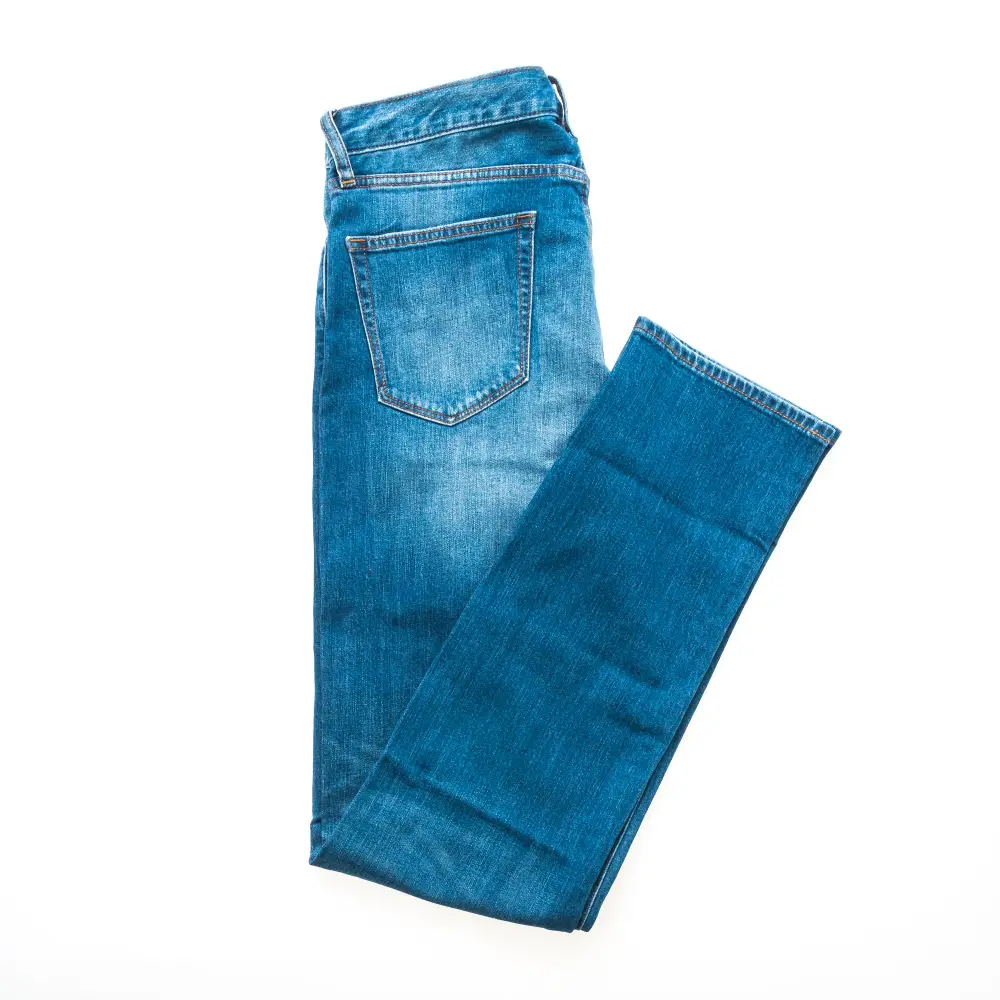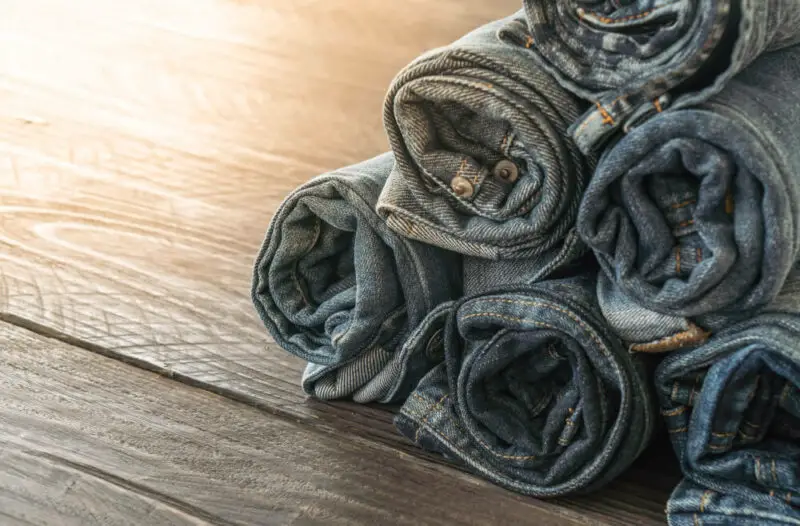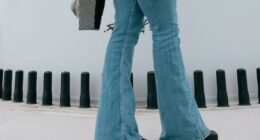Denim is the fabric, typically made of cotton, while jeans are garments made from denim fabric, commonly used as pants or trousers.
Denim and jeans are often used interchangeably, but they are not the same. Denim is a type of fabric, while jeans are a specific style of pants that are made from denim fabric. This article will delve into the distinct characteristics of denim and jeans, exploring what sets them apart.
https://www.youtube.com/watch?v=h6GzTFOKG4I
Key Takeaways:
- Denim: Denim is a sturdy cotton fabric woven in a twill pattern with diagonal ribbing. It is known for its durability and breathability. Denim is used in the production of various garments, including jeans.
- Jeans: Jeans are a style of pants made from denim fabric. They are characterized by their sturdy construction, riveted pockets, and unique style details. Jeans come in different cuts and are known for their versatility and timeless appeal.
- Difference: Denim refers to the fabric, while jeans are a specific style of pants made from denim. Denim fabric has diagonal ribbing and is durable, while jeans have design elements like riveted pockets and metal hardware.
- Care: To prevent fraying, choose 100% denim fabric jeans and avoid letting them drag on the ground. Follow the care label instructions for cleaning and maintenance. High-quality jeans and patching can prolong their lifespan.
- Market: The global denim jeans market is experiencing steady growth, driven by increasing demand and changing fashion trends. Key players in this market include Inditex, Levi Strauss & Co., and H&M.
What is Denim?

Denim is a sturdy cotton fabric that is woven in a twill pattern. It is known for its diagonal ribbing, which is created by the weft (horizontal) yarn passing under two or more warp (vertical) yarns. Denim is typically made from 100% cotton and is known for its durability, breathability, and resistance to fading. It is commonly used in the production of jeans, jackets, and other garments.
Denim fabric is highly versatile and is valued for its unique characteristics. Some of the key characteristics of denim fabric include:
- Sturdiness: Denim’s tight weave and strong fibers make it highly durable and resistant to wear and tear.
- Breathability: The natural cotton fibers in denim allow air to circulate, making it comfortable to wear in various climates.
- Diagonal Ribbing: The distinct diagonal pattern of denim fabric gives it a unique texture and visual appeal.
- Versatility: Denim can be dyed in various colors and finishes, allowing for a wide range of style options.
- Resistance to Fading: Denim fabric is known for its ability to retain its color even after multiple washes.
Denim production involves several stages, including cotton cultivation, yarn spinning, weaving, dyeing, and finishing. The production process contributes to the unique characteristics and quality of denim fabric.
In the next section, we will explore the characteristics and versatility of jeans, which are made from denim fabric.
What are Jeans?

Jeans are a style of pants that are made from denim fabric. They are known for their durability, comfort, and timeless appeal. Jeans have become a staple in casual wear and are worn by people of all ages and genders.
Jeans boast several distinct characteristics that set them apart from other types of pants:
- Sturdy Construction: Jeans are designed to withstand daily wear and tear. They are made with reinforced stitching, double seams, and durable materials to ensure longevity.
- Riveted Pockets: One of the iconic features of jeans is their riveted pockets. These metal fasteners add strength and stability to the pockets, preventing them from tearing or fraying.
- Unique Style Details: Jeans often feature contrast stitching and metal hardware, such as buttons and rivets. These details contribute to the overall aesthetic of the pants and add a touch of individuality.
Jeans come in a variety of cuts and styles to cater to different preferences and body types. Some common types of jeans include:
- Skinny Jeans: Skinny jeans are form-fitting and tapered from the waist to the ankle. They offer a sleek and streamlined silhouette.
- Straight Jeans: Straight jeans have a straight fit from the waist to the ankle. They provide a classic and timeless look.
- Bootcut Jeans: Bootcut jeans are fitted at the waist and hips and gradually flare out from the knee to accommodate boots or other footwear.
- Flare Jeans: Flare jeans feature a dramatic flare from the knee down, creating a retro-inspired silhouette.
In terms of production, jeans are made using denim fabric. Denim is a sturdy cotton fabric that is woven in a twill pattern, resulting in its characteristic diagonal ribbing. It is known for its durability, breathability, and resistance to fading. Denim is typically made from 100% cotton and is highly versatile, making it suitable for a wide range of clothing items, including jeans.
| Jeans Fabric Characteristics | Jeans Production | Jeans Material |
|---|---|---|
| Sturdy and durable | Manufactured using specialized techniques, including cutting, sewing, and finishing | Primarily made from 100% cotton denim fabric |
| Comfortable and breathable | May involve additional processes such as distressing, aging, or embellishments | May incorporate small amounts of elastane or other stretch fibers for added comfort and flexibility |
| Resistant to fading | Can be produced in a variety of washes, colors, and finishes | May also include other fibers or blends, such as polyester or elastane, for specific characteristics |
With their enduring popularity, jeans have become a fashion staple that seamlessly blends style and comfort. Whether you’re dressing up or going for a casual look, jeans are a versatile choice that can be easily paired with a variety of tops and footwear.
The History of Denim and Jeans
Denim has a fascinating history that can be traced back to the 18th century. The fabric originated in Nimes, France, and was initially known as “serge de Nimes.” However, it gained immense popularity and recognition in the United States during the California Gold Rush.
During this time, denim fabric was primarily used to produce sturdy work pants for miners. The fabric’s durability and strength made it ideal for the demanding conditions faced by these workers. It wasn’t long before denim pants became a staple in the wardrobes of gold miners and laborers.
One prominent figure in the history of denim and jeans is Levi Strauss. A German immigrant, Strauss recognized the potential of denim fabric and began manufacturing denim pants in San Francisco. These pants, known as “jeans,” were an instant hit among workers and laborers due to their durability and comfortable fit.
Levi Strauss, along with his business partner Jacob Davis, is credited with inventing the copper-riveted denim jeans that we know today. The copper rivets added strength to stress points, making the jeans even more long-lasting.
Over the years, denim manufacturing has undergone significant advancements in technology and techniques. Today, jeans made from denim fabric have become a global fashion phenomenon and an integral part of almost everyone’s wardrobe.
Key Points:
- Denim fabric originated in Nimes, France, in the 18th century.
- During the California Gold Rush, denim fabric gained popularity as sturdy work pants for miners.
- Levi Strauss played a significant role in popularizing denim pants, which became known as jeans.
- Denim manufacturing has evolved with advancements in technology and techniques.
Denim vs. Jeans Fabric
When comparing denim fabric and jeans fabric, it’s essential to understand their construction and specific uses. Denim fabric, a type of twill fabric made from cotton, is known for its distinctive diagonal ribbing and durability. On the other hand, jeans fabric refers to the specific fabric used to make jeans. While both types of fabric share similarities, they also have unique characteristics that set them apart.
Denim Fabric Characteristics
Denim fabric is renowned for its durability and resilience, making it an ideal choice for clothing that requires strength and longevity. The diagonal twill weaving technique used in denim fabric creates a sturdy and robust fabric that can withstand repeated wear and washing. The cotton construction of denim fabric offers breathability and comfort, allowing for easy movement. Additionally, denim fabric is known for its ability to develop a natural fade over time, adding to its aesthetic appeal.
Jeans Fabric Characteristics
Jeans fabric, specifically designed for making jeans, is often heavier and more tightly woven compared to denim fabric. Its thicker construction enhances durability, ensuring that jeans can withstand the rigors of everyday wear. Jeans fabric is known for its resistance to tears and abrasions, making it a reliable choice for workwear and casual clothing. Additionally, jeans fabric often features a higher thread count, resulting in a smoother texture and a substantial weight that gives jeans their characteristic structure and shape.
Denim Fabric Production
The production process of denim fabric involves several steps to achieve its distinctive characteristics. It starts with sourcing high-quality and durable cotton fibers. Then, the cotton fibers undergo various treatments such as dyeing and sizing to enhance their strength and colorfastness. The cotton fibers are then spun into yarns, which are woven using a twill weave technique to create the diagonal ribbing pattern. Finally, the woven fabric is finished and prepared for use in garment production.
Jeans Fabric Production
Jeans fabric production begins with the denim fabric obtained from the previous step. The denim fabric is carefully inspected and cut into pattern pieces that will form the different parts of the jeans, such as the front and back panels, pockets, and waistband. These pattern pieces are then sewn together using specialized sewing machines to create the final jeans. The production process includes various steps like stitching, fitting, attaching buttons and zippers, and adding unique design elements such as rivets and contrast stitching to enhance the overall aesthetic of the jeans.
| Category | Denim Fabric | Jeans Fabric |
|---|---|---|
| Construction | Twill weave with diagonal ribbing | Heavier and tightly woven |
| Durability | High | Excellent |
| Comfort | Breathable and comfortable | Sturdy and comfortable |
| Fade | Develops natural fade over time | Retains color with minimal fading |
Denim vs. Jean Pants
When comparing denim pants and jean pants, it’s important to understand the difference between the two. Denim refers to the fabric used, while jeans refer to the style of pants made from denim fabric.
Denim pants can come in various styles, including jeans, but they can also be used to make other types of bottoms like skirts or shorts. Denim pants are versatile and offer a range of options for different preferences and occasions.
Jean pants, on the other hand, specifically refer to the style of pants that are made from denim fabric and feature certain design elements such as riveted pockets and metal hardware. They are known for their sturdy construction and timeless appeal.
Here is a breakdown of the characteristics of denim pants and jean pants:
Denim Pants Characteristics:
- Versatile – can be used to make various types of bottoms such as jeans, skirts, and shorts
- Durable – known for its robustness and longevity
- Comfortable – provides breathability and ease of movement
- Range of options – available in different colors, washes, and finishes
Jean Pants Characteristics:
- Distinct style – characterized by riveted pockets and metal hardware
- Sturdy construction – designed to withstand everyday wear and tear
- Timeless appeal – a classic style that transcends fashion trends
- Various cuts and fits – offers options such as skinny, straight, bootcut, and flare
In summary, denim pants encompass a broader category of bottoms made from denim fabric, while jean pants specifically refer to the style of pants that feature distinctive design elements. Both denim pants and jean pants have their own unique characteristics and can be chosen based on individual preferences and style.
Selvage Denim vs. Regular Denim
In the world of denim, two terms often come up: selvage denim and regular denim. While both are popular choices for creating stylish garments, they differ in terms of production, characteristics, and appeal to denim enthusiasts.
Selvage Denim
Selvage denim, also known as selvedge denim, is a type of denim fabric that is woven on shuttle looms. This traditional weaving method creates a self-bound edge on the fabric, which prevents it from unraveling. The selvage edge is typically distinguishable by its clean finish and a colored line running along the fabric’s edge, showcasing the authenticity of the fabric.
Selvage denim is often preferred by denim enthusiasts due to its high-quality craftsmanship and unique characteristics. The intricate weaving process results in a dense, tightly woven fabric that is known for its durability and longevity. The unique selvage edge adds a touch of authenticity and heritage to the fabric, making it highly sought after by those who appreciate the fine details of denim production.
Regular Denim
Regular denim, on the other hand, is woven on shuttle-less looms, which differ from shuttle looms in their weaving technique. The absence of a shuttle in the loom results in a wider fabric width and a frayed edge on both sides. This frayed edge is often trimmed off during the garment construction process to create a clean finish, but it is a defining characteristic of regular denim fabric.
Regular denim fabric is widely used in the fashion industry and is known for its durability and versatility. It can be found in a variety of denim garments, including jeans, jackets, and skirts. While it may lack the intricate details and selvage edge of selvage denim, regular denim fabric still offers excellent quality and performance.
It’s important to note that both selvage denim and regular denim have their own unique appeal and usage. Selvage denim is cherished for its craftsmanship and authenticity, often associated with high-end denim brands and timeless styles. Regular denim, on the other hand, offers a wide range of options in terms of styles, washes, and fits, making it a popular choice for everyday wear.
Preventing Denim Jeans from Unraveling
To keep your denim jeans in good condition and prevent them from fraying, follow these essential tips for denim jeans care and maintenance.
Choose 100% Denim Fabric
When purchasing denim jeans, opt for styles made from 100% denim fabric. Synthetic materials like polyester can increase the risk of fraying. The natural durability of denim fabric provides better protection against unraveling.
Avoid Dragging on the Ground
Dragging the bottom of your jeans on the ground can cause damage and lead to fraying over time. Take care to ensure the length of your jeans is appropriate, allowing them to hang freely without touching the ground.
Check Care Labels
Every pair of denim jeans comes with care instructions on the label. It is crucial to follow these instructions when cleaning and caring for your jeans. Different wash and care methods can affect the overall condition of the fabric, so be sure to read and follow the specific guidelines.
Invest in High-Quality Jeans
Investing in high-quality denim jeans can make a significant difference in their durability and lifespan. Quality jeans often have reinforced stitching and stronger fabric, minimizing the risk of fraying. Opt for reputable brands known for their craftsmanship and use of premium denim.
Patch Damaged Areas
If you notice any frayed or damaged areas on your denim jeans, patching them can help prevent further unraveling. Use a matching denim fabric or a decorative patch for a personalized touch. Patching can also add a unique design element to your jeans.
By following these preventive measures for denim jeans, you can ensure that your favorite pair stays in great condition, extending their longevity and preserving their stylish appeal.
The Global Denim Jeans Market
The global denim jeans market is a thriving industry that continues to grow at a steady pace. With a projected compound annual growth rate (CAGR) of 4.2% during the forecast period, the market shows promising potential for both new and established players.
The driving force behind the growth of the denim jeans market is the increasing demand from diverse demographics, including men, women, and children. Denim jeans have become a staple in fashion and are widely worn for their style, comfort, and versatility.
The market is segmented based on product types, which include economy, standard, and premium jeans. This segmentation allows manufacturers to cater to different consumer preferences and price points, emphasizing the wide range of options available in the market.
Several key players dominate the global denim jeans market, including industry giants such as Inditex, Levi Strauss & Co., H&M, and Gap. These brands have established a strong presence in the market and continue to lead through their innovative designs, quality products, and effective marketing strategies.
The denim jeans market is influenced by various factors, including changing fashion trends, evolving consumer preferences, and advancements in denim manufacturing technology. Manufacturers are consistently adapting to these trends and using cutting-edge techniques to produce jeans that align with the latest market demands.
As the market continues to evolve, industry experts forecast a positive outlook for the global denim jeans market. With the expanding customer base and the introduction of sustainable denim production practices, the market is expected to witness substantial growth in the coming years.
Conclusion
In conclusion, denim and jeans are distinct but closely related. Denim refers to the fabric, while jeans are a specific style of pants made from denim fabric. Denim is known for its durability, breathability, and unique diagonal ribbing, while jeans are characterized by their sturdy construction, riveted pockets, and various style details. Understanding the difference between denim and jeans can help you make informed decisions when purchasing and caring for denim jeans.
Key takeaways from this article include:
- Denim is a type of fabric, while jeans are a style of pants made from denim fabric.
- Denim is known for its durability, breathability, and unique diagonal ribbing.
- Jeans are characterized by their sturdy construction, riveted pockets, and various style details.
- Both denim and jeans are versatile and timeless, making them popular choices for casual wear.
- Proper care and maintenance, such as choosing 100% denim fabric and avoiding dragging jeans on the ground, can help prevent fraying and prolong the lifespan of denim jeans.
By understanding the characteristics and differences between denim and jeans, you can make well-informed decisions when purchasing denim jeans, ensuring that you choose the right style, fit, and fabric that suits your preferences and needs. Whether you’re a denim enthusiast or simply a fan of comfortable and stylish pants, denim jeans are a wardrobe staple that will stand the test of time.
FAQ
What is the difference between denim and jeans?
Denim is a type of fabric, while jeans are a specific style of pants made from denim fabric.
What is denim?
Denim is a sturdy cotton fabric that is woven in a twill pattern and known for its durability, breathability, and resistance to fading.
What are jeans?
Jeans are a style of pants made from denim fabric, characterized by their sturdy construction, riveted pockets, and unique style details.
What is the history of denim and jeans?
Denim has a rich history dating back to the 18th century, originating in Nimes, France. Jeans gained popularity during the California Gold Rush, and Levi Strauss played a significant role in popularizing them.
What is the difference between denim fabric and jeans fabric?
Denim fabric is a type of twill fabric made from cotton, known for its diagonal ribbing and durability. Jeans fabric specifically refers to the fabric used to make jeans and is often heavier and more tightly woven.
What is the difference between denim pants and jean pants?
Denim pants can refer to any bottoms made from denim fabric, including jeans. Jean pants specifically refer to the style of pants made from denim fabric and feature design elements such as riveted pockets and metal hardware.
What is selvage denim?
Selvage denim, also known as selvedge denim, is denim fabric woven on shuttle looms, known for its self-bound edge and high-quality craftsmanship.
How can I prevent denim jeans from unraveling?
Choose jeans made from 100% denim fabric and avoid materials like polyester. Avoid letting the bottom of the jeans drag on the ground and follow the care label instructions for cleaning and maintenance.
What is the global denim jeans market like?
The global denim jeans market is experiencing steady growth, driven by increasing demand from various demographics and influenced by changing fashion trends and advancements in manufacturing technology.
What are the key differences between denim and jeans?
Denim refers to the fabric used, while jeans refer to the style of pants. Denim is known for its durability and unique ribbing, while jeans are characterized by their construction and style details.
Source Links
- https://www.nudiejeans.com/blog/selvage-denim
- https://www.makeyourownjeans.com/blog/protecting-the-bottom-of-your-denim-jeans-from-unraveling/
- https://www.linkedin.com/pulse/denim-jeans-market-unraveling-growth-prospects-trends
Image Credits
Featured Image By – topntp26 on Freepik
Image 1 By – Freepik
Image 2 By – mrsiraphol on Freepik








